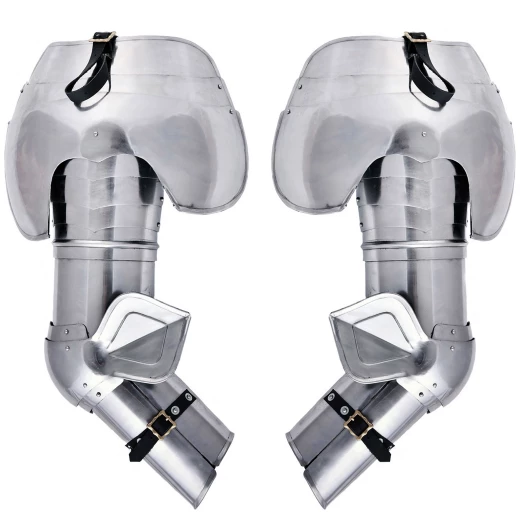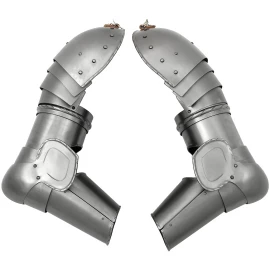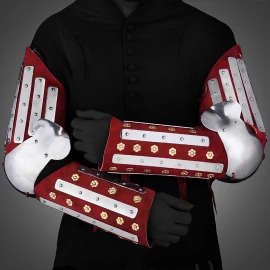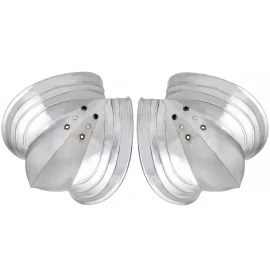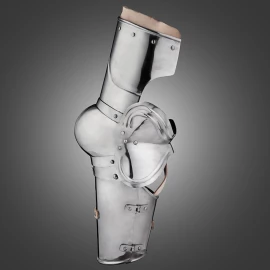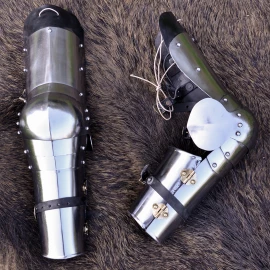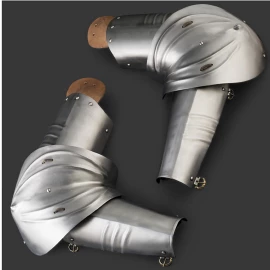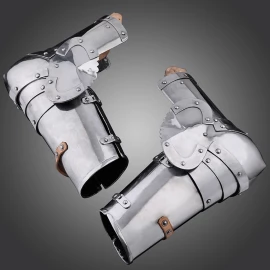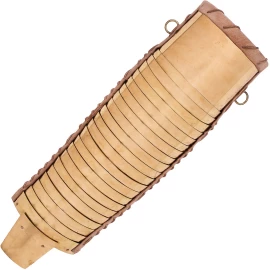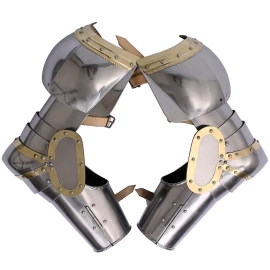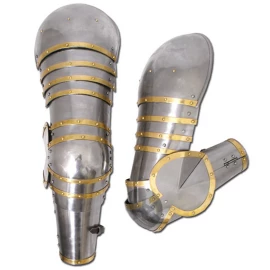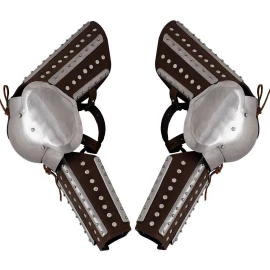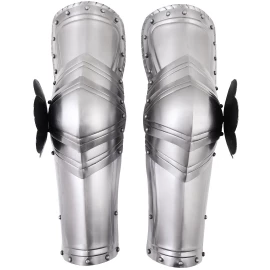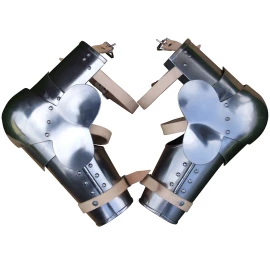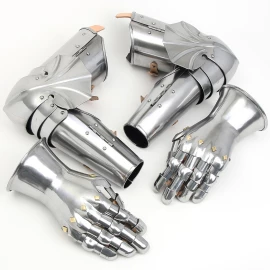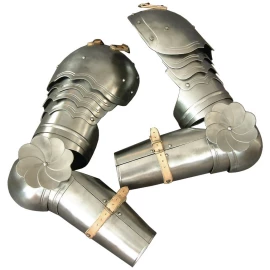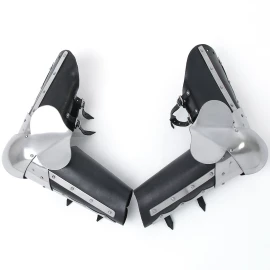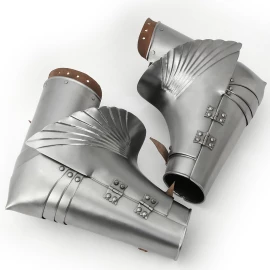Complete Steel Plate Arm Armour (Pair) – 1.6mm Late Medieval for Reenactment & LARP
Equip yourself like a knight ready for battle! This pair of complete plate arm armour provides maximum coverage from shoulder to wrist. Crafted from durable 1.6mm thick steel, this fully articulated harness combines robust late medieval protection with surprising mobility, essential for reenactment, LARP, or historical combat. Its complex design and gleaming metallic finish represent a masterful display of the armourer's craft. More information...
Complete Steel Plate Arm Armour (Pair) – 1.6mm Late Medieval for Reenactment & LARP
Each arm harness consists of several meticulously joined components: a large pauldron covering the shoulder, a fully enclosed tubular rerebrace for the upper arm, an articulated couter protecting the elbow (featuring characteristic protective side wings or 'fans'), and a fully enclosed tubular vambrace for the forearm. All parts are constructed from approx. 1.6mm thick steel plate, guaranteeing high resistance against impacts. Thanks to the well-designed articulation using rivets and internal leather straps, the armour allows a considerable range of motion at the shoulder and elbow, crucial for effective combat. The total length of one complete arm harness is approximately 63 cm (24.8 inches), and the total weight for the pair is around 7.9 kg (17.4 lbs), testament to its massive build and protective potential. This armour is designed to fit individuals approximately 170 cm to 180 cm (5'7" to 5'11") tall. A leather strap with a quality brass buckle is riveted to the top of the pauldron for easy and secure attachment to a gambeson, brigandine, gorget, or cuirass. Additional straps with buckles on the vambrace ensure a snug fit to the arm.
Who Wore Full Plate Arm Armour?
Complete plate protection for the limbs became the defining characteristic of heavy armoured warriors in the Late Middle Ages, particularly the 15th century, when the craft of the armourer reached its zenith. Knights and professional soldiers (men-at-arms) invested in increasingly sophisticated suits of plate armour that offered the maximum possible protection on the battlefield and in tournament settings (the 'mechanical sports' of the era). Fully enclosed and articulated arm defences were an essential component of this equipment, guarding against the cuts, thrusts, and crushing blows of swords, axes, war hammers, and other contemporary weapons. They were employed in major battles (like those of the Hundred Years' War and the Wars of the Roses), during sieges, and at prestigious knightly tournaments.
How Can You Use This Arm Armour Today?
This pair of plate arms is ideal for:
- Late Medieval Reenactment: An indispensable and visually dominant part of a 15th-century knight or man-at-arms harness.
- LARP: For characters demanding maximum protection and an imposing, intimidating appearance – knights, paladins, heavy warriors, elite guards, or commanders.
- Historical Full Contact Combat (HMB, Buhurt): The robust 1.6mm steel thickness may make this armour suitable for certain combat categories (always check the current specific rules and requirements for your competition!).
- Collections and Display: An impressive example of highly developed plate armour, striking in any militaria collection or historical exhibit.
A Historical Tidbit
Did you know that producing a full suit of plate armour was incredibly laborious and expensive? It required a team of specialised craftsmen – armourers (or 'platners') – who needed mastery not only of smithing and metallurgy but also precise cold-shaping of steel plates using various hammers and anvils, riveting, grinding, polishing, and often decoration through techniques like etching or gilding. The cost of a high-quality, custom-fitted suit of armour in the 15th century could equate to the value of a small country estate or several years' income for an average craftsman!
How to Care For Your Arm Armour
To ensure your plate arm armour lasts for many battles:
- Keep Dry: Steel rusts easily. After every use, especially in damp conditions or after heavy exertion, thoroughly wipe the armour dry with a soft, absorbent cloth. Don't leave it lying on wet grass or in a damp tent.
- Conservation: Regularly (ideally after each use or at least before long-term storage) treat all steel surfaces (inside and out!) with a thin coat of conservation oil (WD-40, Ballistol, gun oil, etc.). Pay special attention to joints, rivets, and plate edges. Carefully wipe off excess oil to avoid staining clothing.
- Strap Maintenance: Regularly check the condition and integrity of all leather straps and the function of the buckles. Keep the leather dry. Occasionally treat it with a suitable leather conditioner or balm to keep it supple and prevent hardening or cracking.
- Storage: Store in a dry, well-ventilated area. Hanging on a suitable armour stand or laying flat to prevent distortion and allow air circulation is ideal. Avoid prolonged contact with damp textiles or other corrosive materials.
Don't leave your arms undefended in the fray! With this complete plate arm armour, you gain not only historical authenticity but, crucially, a robust shield against your opponents' blows. Invest in your safety and battlefield presence. Order this key pair for your knightly harness today!
We are here for you


